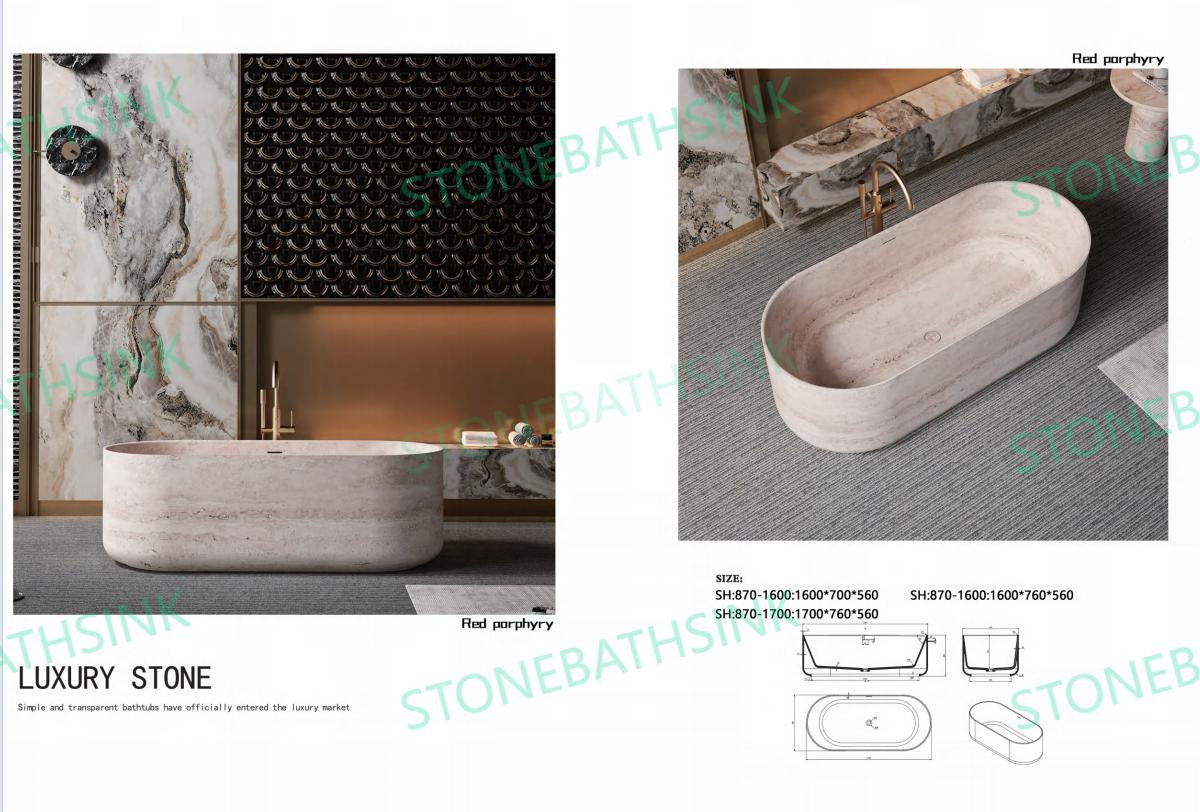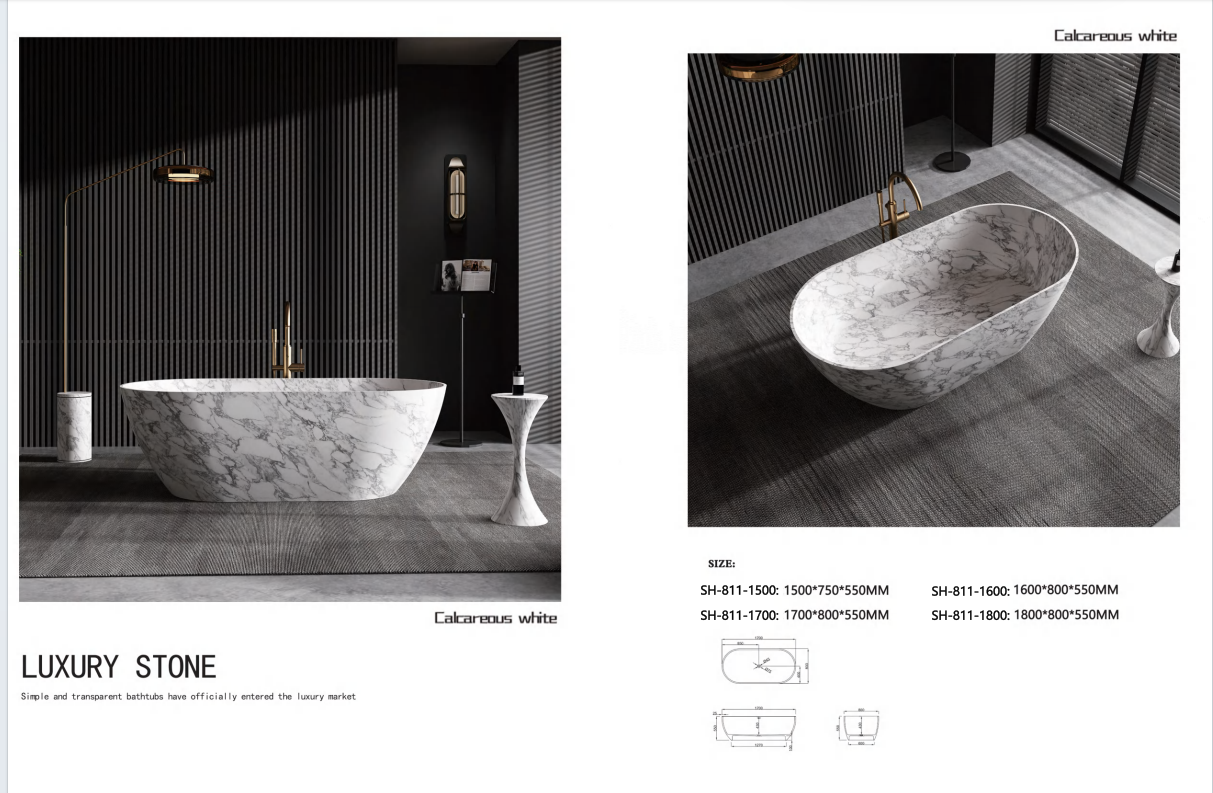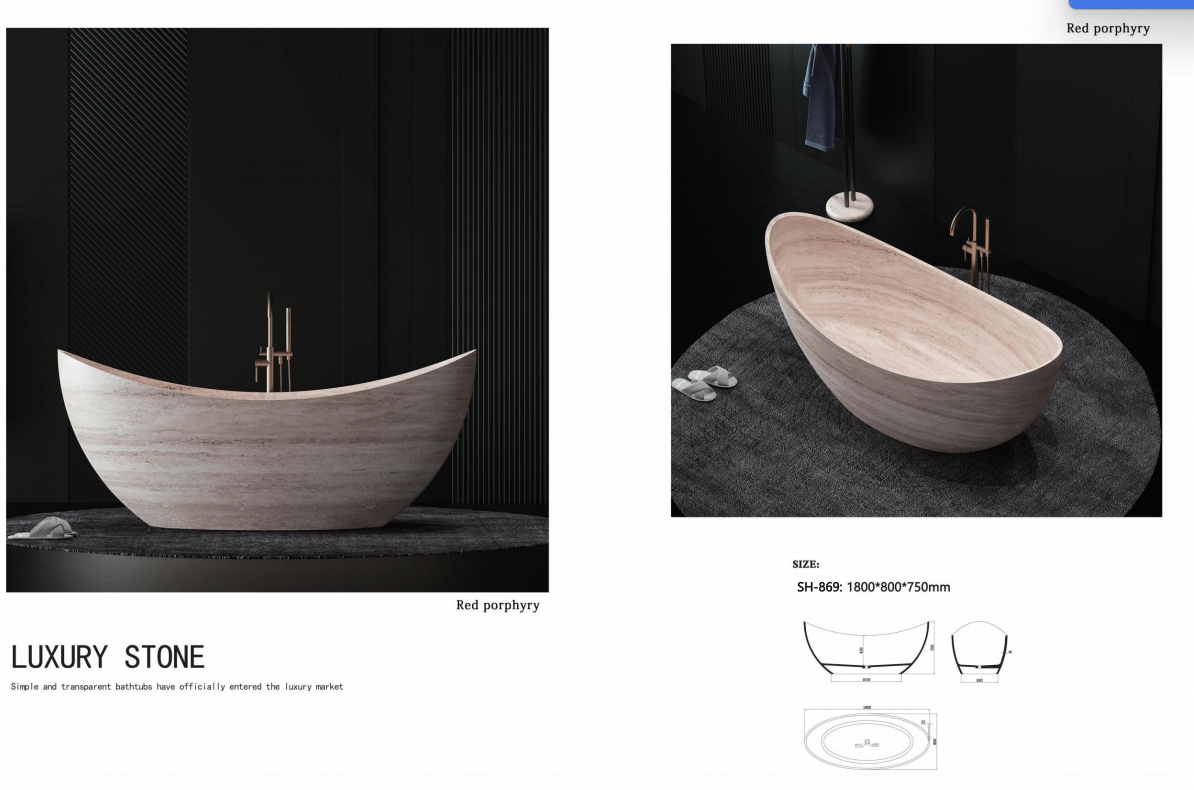Detailed Explanation of Marble Bathtub and Related Bathtub Materials
1. Marble Bathtub
1.1 Material Properties
**

Marble is a metamorphic rock formed from limestone under high pressure and heat. It is renowned for its distinctive veining patterns, which are the result of minerals such as quartz, mica, and iron oxide infiltrating the limestone during the metamorphosis process. Each marble bathtub is a unique work of art, as no two pieces of marble have identical veining. The color palette of marble is diverse, ranging from the classic white of Carrara marble, which exudes a sense of purity and elegance, to the more dramatic and luxurious veined varieties like Calacatta marble with its bold, golden - hued streaks.
In terms of physical properties, marble is relatively soft compared to some other natural stones used in bathtubs, with a Mohs hardness rating of around 3 - 5. This means it is prone to scratching and etching. For example, acidic substances such as bath products containing citric acid or vinegar can etch the surface of the marble, leaving dull spots. However, its softness also allows for intricate carving and shaping, enabling the creation of elaborate bathtub designs with ornate details.
1.2 Advantages
One of the most significant advantages of a marble bathtub is its aesthetic appeal. The natural beauty of marble instantly elevates the look of any bathroom, creating a spa - like, luxurious atmosphere. It is a statement piece that can transform a mundane bathroom into a high - end, sophisticated space. Additionally, marble has excellent heat - retention properties. When filled with warm water, a marble bathtub stays warm for an extended period, enhancing the bathing experience by providing a consistently comfortable temperature.
Marble is also a durable material when properly maintained. With regular sealing and care, a marble bathtub can last for decades, making it a long - term investment. Its timeless elegance means that it never goes out of style, remaining a classic choice for bathroom design across different eras and trends.
1.3 Disadvantages
As mentioned earlier, the susceptibility to scratching and etching is a major drawback of marble bathtubs. 日常使用中,即使是微小的沙粒或指甲刮擦都可能在其表面留下痕迹。 Maintenance can be quite demanding. Marble needs to be sealed regularly, usually once or twice a year, to protect it from stains and etching. Failure to do so can lead to the absorption of liquids, resulting in unsightly stains that are difficult to remove.
Another consideration is the weight of marble. Marble bathtubs are extremely heavy, which can pose challenges during installation. The bathroom floor may need to be reinforced to support the weight of the bathtub, adding to the installation cost and complexity. Moreover, marble bathtubs tend to be more expensive compared to bathtubs made of other materials, both in terms of the initial purchase price and long - term maintenance costs.

1.4 Design and Installation
Marble bathtubs come in a wide variety of designs, from freestanding clawfoot tubs that evoke a sense of vintage charm to sleek, modern - style drop - in or undermount tubs. Freestanding marble bathtubs are often the centerpiece of a bathroom, drawing the eye and becoming the focal point of the room. When installing a marble bathtub, it is crucial to hire experienced professionals. The heavy weight and delicate nature of marble require careful handling to avoid damage during transportation and installation.
2. Bathtub in General
2.1 Common Materials and Their Characteristics
Bathtubs can be made from a plethora of materials, each with its own set of features. Acrylic is one of the most popular materials. It is lightweight, which makes installation relatively easy and cost - effective. Acrylic bathtubs are also affordable, available in a wide range of colors and styles, and are resistant to stains and scratches compared to marble. However, they may not have the same high - end aesthetic or heat - retention properties.
Fiberglass is another commonly used material. It is even lighter than acrylic and is often the most budget - friendly option. Fiberglass bathtubs are easy to install but are more prone to cracking and scratching over time. Porcelain - enameled steel bathtubs offer a smooth, glossy surface that is easy to clean and durable. They are resistant to stains and scratches to some extent but can chip if a heavy object is dropped on them.
2.2 Functionality and Versatility

General bathtubs are designed to meet various needs. They come in different sizes, from small corner tubs suitable for compact bathrooms to large, spacious soaking tubs for those who desire a more luxurious bathing experience. Some bathtubs are equipped with additional features such as jets for hydrotherapy, which can provide a therapeutic massage effect, enhancing relaxation and promoting blood circulation.
The versatility of bathtubs also extends to their installation options. They can be installed as drop - in tubs, where the bathtub is placed into a pre - formed deck; undermount tubs, which are installed beneath the bathroom countertop for a seamless look; or freestanding tubs, which offer more flexibility in bathroom layout and can be positioned anywhere in the room.
3. Granite Bathtub
3.1 Material Properties
Granite is an igneous rock formed from the slow crystallization of magma beneath the Earth's surface. It is composed mainly of quartz, feldspar, and mica, giving it a unique and varied appearance. Granite has a much higher Mohs hardness rating, typically around 6 - 7, making it one of the hardest natural stones used in bathtub manufacturing. This high hardness makes granite extremely resistant to scratching, chipping, and etching.
The color and pattern variations in granite are vast. It can range from solid - colored varieties to those with intricate speckled or swirled patterns. Unlike marble, which has more linear veining, granite's patterns are often more random and diverse, creating a unique and natural look for each bathtub.
3.2 Advantages
The durability of granite bathtubs is one of their most significant advantages. Their resistance to damage means they can withstand the rigors of daily use without showing signs of wear and tear easily. They require minimal maintenance compared to marble bathtubs. While it is still advisable to seal granite periodically, the intervals between sealings can be much longer, sometimes up to several years.
Granite also has excellent heat - retention capabilities, similar to marble, ensuring a warm and comfortable bathing experience. In terms of aesthetics, granite bathtubs offer a more rugged and natural look. They can add a touch of earthy elegance to a bathroom, complementing both traditional and contemporary design styles.
3.3 Disadvantages
One of the main drawbacks of granite bathtubs is their weight. Like marble, granite is a heavy material, which can make installation challenging and costly. The installation process may require special equipment and skilled labor to ensure the bathtub is properly placed and the floor can support its weight.
Another consideration is the cost. Granite bathtubs can be quite expensive, especially if you choose high - quality, rare varieties. Additionally, the rough texture of some granite types may not be as comfortable to lie against as the smoother surface of marble or acrylic bathtubs, although this can be mitigated by choosing a variety with a more refined finish.
3.4 Design and Installation
Granite bathtubs are available in a range of designs, including freestanding, drop - in, and undermount styles. Their natural beauty and durability make them a popular choice for those who want a bathtub that combines functionality with a long - lasting, attractive appearance. During installation, careful planning is required to ensure the structural integrity of the bathroom floor. Professional installers will also take into account the unique shape and weight of the granite bathtub to ensure a secure and level installation.
4. Travertine Tubs
4.1 Material Properties
Travertine is a sedimentary rock formed from the accumulation of calcium carbonate deposits, often in hot spring or limestone cave environments. It has a porous texture, with visible holes and pits that are characteristic of the material. These holes are a result of the gas bubbles that were trapped during the formation process. Travertine comes in a variety of earthy tones, including beige, tan, brown, and ivory, giving it a warm and inviting appearance.
In terms of hardness, travertine has a Mohs hardness rating of around 3 - 4, similar to marble. This makes it relatively soft and prone to scratching and etching. However, its porous nature also means it has a unique, textured surface that can add a rustic and natural charm to a bathroom.
4.2 Advantages
The aesthetic appeal of travertine tubs lies in their natural, earthy look. They can create a warm and cozy atmosphere in the bathroom, reminiscent of a natural spa or a rustic retreat. Travertine is also a relatively lightweight material compared to marble and granite, which can make installation easier and more cost - effective.
Like marble and granite, travertine has some heat - retention properties, providing a comfortable bathing temperature for a reasonable period. Additionally, travertine tubs can be customized to a certain extent, with options for different finishes, such as polished, honed, or tumbled, to achieve the desired look.
4.3 Disadvantages
The porous nature of travertine is both a blessing and a curse. While it gives the material its unique texture, it also makes travertine highly susceptible to staining. Liquids, dirt, and grime can easily penetrate the pores, leaving behind stubborn stains. Regular sealing is essential to protect the travertine tub, and even with sealing, it requires more frequent cleaning and maintenance compared to non - porous materials like acrylic.
The softness of travertine also means it is more likely to be damaged by sharp objects or rough handling. Chips and scratches can be difficult to repair, and over time, the surface may lose its luster if not properly cared for.
4.4 Design and Installation
Travertine tubs are commonly found in freestanding and drop - in styles. Their natural, textured appearance makes them a great choice for bathrooms with a Mediterranean, rustic, or natural - themed design. During installation, it is important to ensure that the travertine tub is properly sealed before use. Installers also need to be careful not to damage the relatively soft surface during the installation process.
5. Comparison and Considerations
5.1 Aesthetic Comparison
Marble bathtubs offer a classic, elegant, and luxurious look with their smooth surfaces and distinctive veining. They are perfect for creating a high - end, sophisticated bathroom atmosphere. Granite bathtubs, on the other hand, have a more rugged and natural appearance, adding an earthy elegance that can suit a variety of design styles. Travertine tubs bring a warm, rustic charm with their porous, textured surfaces and earthy tones, ideal for those who want a more natural - feeling bathroom. General bathtubs made from materials like acrylic or fiberglass can offer a wide range of modern and traditional styles, but may lack the natural, high - end aesthetic of natural stone bathtubs.
5.2 Durability and Maintenance Comparison
Granite bathtubs are the most durable in terms of resistance to scratching, chipping, and etching, requiring the least frequent maintenance among the natural stone options. Marble bathtubs are durable but demand regular sealing and careful handling to prevent damage. Travertine tubs are the most maintenance - intensive due to their porous nature, needing frequent sealing and cleaning to avoid staining. General bathtubs made from acrylic or fiberglass can be quite durable with proper care, but they may be more prone to cracking or scratching over time compared to natural stone bathtubs.
5.3 Cost Comparison
Marble bathtubs are generally on the higher end of the price spectrum, both in terms of the initial purchase and long - term maintenance costs. Granite bathtubs can also be expensive, especially for high - quality varieties. Travertine tubs are usually more affordable than marble and granite but still cost more than many acrylic or fiberglass bathtubs. General bathtubs made from common materials like acrylic or fiberglass are the most budget - friendly options, making them a popular choice for those on a tight budget.
5.4 Installation Considerations
The weight of marble and granite bathtubs makes their installation more complex and costly, often requiring floor reinforcement and professional installation. Travertine tubs are lighter but still need careful handling due to their softness. General bathtubs made from lightweight materials like acrylic or fiberglass are the easiest to install, which can save on installation costs.
In conclusion, the choice between a marble bathtub, granite bathtub, travertine tub, or a bathtub made from other materials depends on various factors such as personal aesthetic preferences, budget, desired level of maintenance, and the overall design of the bathroom. Each type of bathtub has its own unique qualities that can enhance the bathing experience and the look of the bathroom, making the selection process an important consideration in creating the perfect bathroom retreat.



